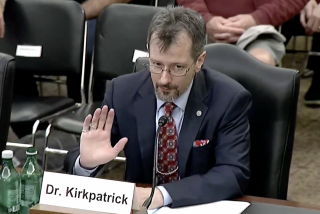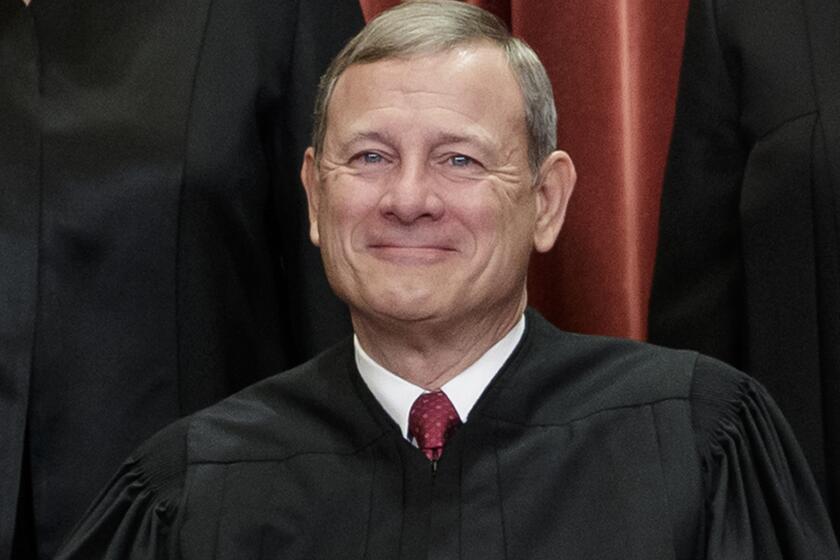McVeigh Jury Told Key Lab Report Flawed
- Share via
DENVER — The chief whistle-blower in the FBI crime laboratory scandal testified Tuesday that widespread contamination had placed the lab in jeopardy and that he disagrees with testing done on a key piece of evidence that the government says links defendant Timothy J. McVeigh to the Oklahoma City bombing.
Frederic Whitehurst, a supervisory special agent, told the jury that he no longer accepts the lab’s scientific conclusion that a piece of a Ryder truck found after the April 1995 explosion showed evidence of ammonium nitrate.
Steven Burmeister, another FBI lab official, testified for the government earlier in the trial that the piece of truck debris was embedded with ammonium nitrate crystals similar to those allegedly used to build the bomb.
In a legal deposition taken in December in preparation for the trial, Whitehurst said Burmeister’s finding was “brilliant.”
But on the witness stand Tuesday, he testified that he has changed his opinion because a heavy rainstorm later on the day of the bombing would have dissolved the crystals.
“Ammonium nitrate crystals pick up water very quickly,” he said. “I don’t know how ammonium nitrate can survive if it went through a rainstorm.”
Asked whether it mattered if the truck piece landed face down and was protected from falling rainwater, as the government contends, Whitehurst said the crystals still could not last in a condition of “100% humidity.”
Whitehurst’s testimony brought into the open the disputes among individual FBI officials on how scientific work at the lab is conducted and whether individual criminal cases have been placed in jeopardy because of problems with contamination and slip-shod examinations.
His allegations of faulty science and poor conditions at the lab in Washington led to sweeping changes announced recently by senior law enforcement officials.
After the Justice Department’s inspector general recently determined that many of Whitehurst’s allegations were valid, the FBI said it will build a new lab and, for the first time, seek outside accreditation of its scientific research.
The scandal also led to the removal of several lab officials, including Whitehurst.
Defense attorneys sought to have the entire inspector general’s report admitted into evidence for the jury. However, prosecutors objected to its relevance, particularly as the report deals with numerous cases other than the Oklahoma City tragedy, in which 168 people died.
U.S. District Judge Richard P. Matsch ruled that only portions of the report dealing with examinations of McVeigh’s clothing will be allowed. With that in mind, defense lawyers said they will decide today how they wish to proceed.
In his testimony, Whitehurst was quizzed about the lab by defense attorney Chris Tritico, who also asked Whitehurst for his opinion of various FBI agents who worked there.
About Ron Kelly, who helped collect evidence samples at the scene of the bombing and testified for the government about how the evidence was gathered, labeled and processed, Whitehurst said: “I don’t think at that time that Mr. Kelly had the hands-on experience to know what he was doing.”
About Chemistry/Toxicology Unit chief Roger Martz, who was one of those removed from the lab, and whether he practiced “good science” at the time of the bombing, Whitehurst said: “I don’t think that he did, sir. He hadn’t been trained, tested or qualified.”
And he questioned the credibility of David Williams, an explosives analysis expert who also was removed, because he said Williams flip-flopped on whether the truck piece should be used at the trial since it first was found by a citizen and could have been contaminated before it was tested.
Whitehurst said Williams told him: “We’ve got problems with the chain of custody, so we’re not going to use it.”
The defense contends that the truck piece and several articles of McVeigh’s clothing were contaminated by minute explosive particles that existed in the lab environment. The government argues that explosive debris was found on McVeigh’s clothing because he had helped mix the bomb and place it in the back of the Ryder rental truck.
Whitehurst said the last study for contaminated particles in the lab was conducted a month after the bombing. “We took 50 swabs,” he said. “We found there were some places, four or five, that had some contamination.”
Whitehurst said he did a separate study on just one box of blue jeans that was stored for four years on top of bookshelves in his office. “It was very contaminated,” he said.
At the time of the bombing, he said, there was no FBI protocol “to my knowledge” for monitoring potential contamination problems at the lab.
But on cross-examination from government lawyer Beth Wilkinson, Whitehurst said he could not categorically say whether any of the evidence against McVeigh was compromised.
“I have no knowledge of any actual contamination of any evidence in this case,” he said.
Also testifying for the defense was John Lloyd, a forensic scientist from England who blasted the FBI’s handling and testing of evidence. He criticized the way McVeigh’s clothing was stored in a paper bag and the fact that more extensive tests were not performed to prevent contamination and find more conclusive results.
Asked for his general impression of the FBI laboratory, he said: “I have been very surprised at what I’m afraid is the inadequacy of it.”
More to Read
Sign up for Essential California
The most important California stories and recommendations in your inbox every morning.
You may occasionally receive promotional content from the Los Angeles Times.











